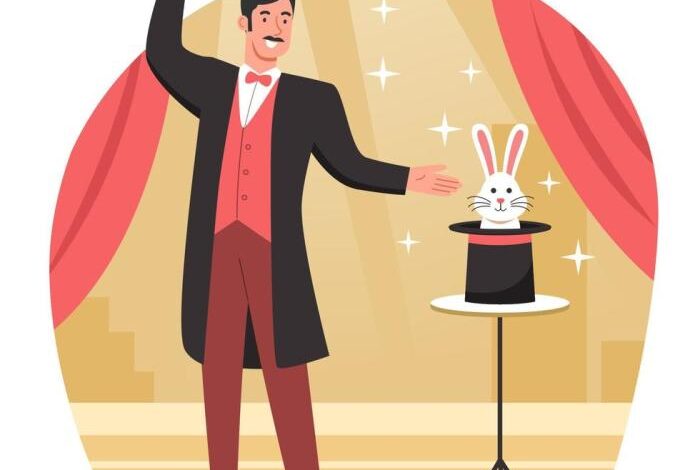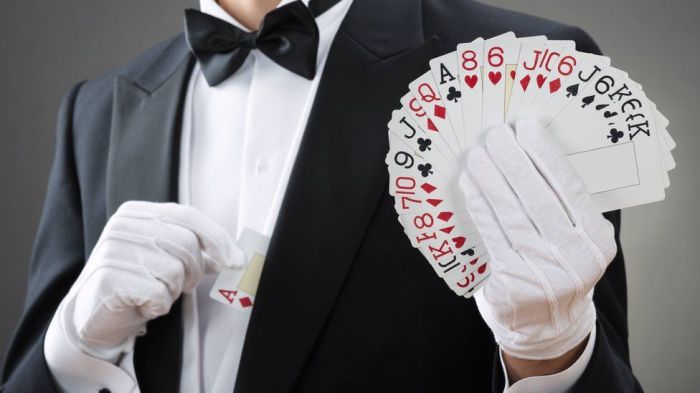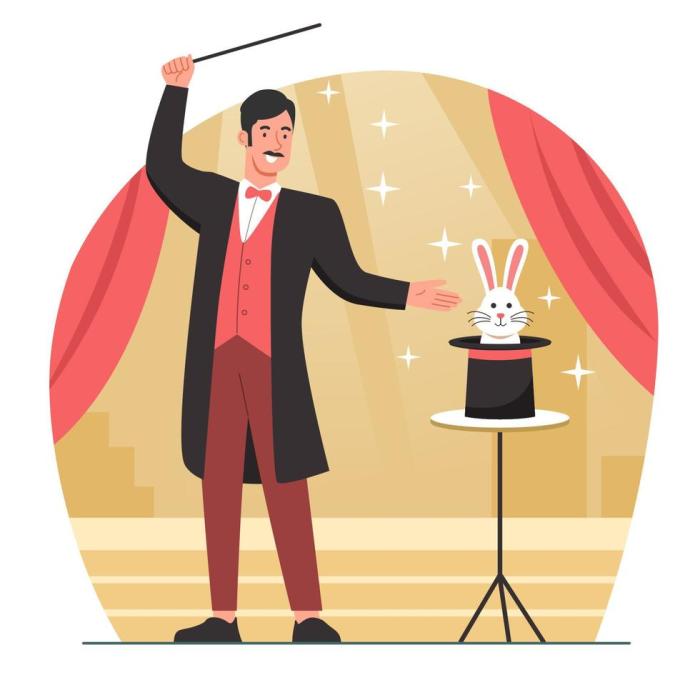
The Great Magic Trick: Unveiling the Secrets of Illusion
The Great Magic Trick: Unveiling the Secrets of Illusion has captivated audiences for centuries, leaving them spellbound and questioning the very nature of reality. From ancient rituals to modern stage spectacles, magic has always held a unique power to amaze and entertain.
This journey delves into the fascinating world of magic tricks, exploring their history, techniques, psychology, and enduring impact on society.
We’ll uncover the origins of magic tricks, tracing their evolution from ancient traditions to the sophisticated illusions of today. We’ll examine the various categories of magic tricks, from sleight of hand and mentalism to grand illusions and escape artistry, revealing the techniques and principles behind each.
We’ll also explore the psychological aspects of magic, understanding how magicians manipulate perception and create illusions that captivate our senses and challenge our understanding of the world.
Psychology of Magic Tricks
Magic tricks, seemingly defying logic and reason, have captivated audiences for centuries. The art of deception, however, goes beyond mere sleight of hand. The true magic lies in the psychology behind the tricks, manipulating our perceptions and creating illusions that leave us bewildered and amazed.
Manipulation of Perception
Magicians skillfully exploit our natural cognitive biases and limitations to create the illusion of the impossible.
- Selective Attention: Our brains have a limited capacity to process information. Magicians capitalize on this by directing our attention to specific elements, while subtly manipulating other aspects of the trick. This creates a blind spot, allowing the magician to perform the necessary movements undetected.
- Change Blindness: We often fail to notice subtle changes in our environment, especially when our attention is focused elsewhere. Magicians use this phenomenon to switch objects, alter positions, or perform other manipulations without our awareness.
- Expectation Bias: Our expectations heavily influence how we perceive the world.
Magicians leverage this by setting up a specific narrative or context, leading us to anticipate a certain outcome. When the actual outcome deviates from our expectations, it creates a sense of astonishment.
Misdirection, Suggestion, and Expectation
The success of a magic trick relies heavily on the skillful use of misdirection, suggestion, and expectation.
- Misdirection: Magicians divert our attention away from the crucial moments of the trick, focusing our focus on irrelevant details. This allows them to perform the necessary actions without our notice.
- Suggestion: Magicians subtly plant ideas and suggestions in our minds, influencing our perception of the trick.
This can involve using specific language, gestures, or even creating a specific atmosphere.
- Expectation: By setting up a narrative or context, magicians create a sense of anticipation and expectation. When the outcome defies these expectations, it creates a sense of wonder and amazement.
Famous Magic Tricks

Magic tricks have captivated audiences for centuries, leaving them wondering how the impossible becomes possible. These illusions, often blending sleight of hand, misdirection, and psychological manipulation, have become part of our cultural fabric, shaping our understanding of perception and reality.
This exploration delves into some of the most famous and influential magic tricks throughout history, examining their techniques, performers, and impact.
The Cups and Balls
This classic trick, dating back to ancient Egypt, involves three cups and a small ball. The magician manipulates the cups, seemingly making the ball vanish, reappear, and multiply.
- History: The Cups and Balls trick has a long and rich history, with evidence of its existence in ancient Egypt, Greece, and Rome. Its popularity continued throughout the Middle Ages and Renaissance, with various versions appearing in magic books and performances.
- Performers: Many renowned magicians have included the Cups and Balls in their repertoires, including Harry Houdini, David Copperfield, and Penn & Teller.
- Techniques: The trick relies on sleight of hand and misdirection. The magician uses various techniques to conceal and reveal the ball, such as palming, loading, and switching. The cups are designed to allow the magician to manipulate the ball without the audience noticing.
A great magic trick can leave you speechless, just like finding the perfect gift. If you’re looking for something truly special, I recently discovered a fantastic resource for two thoughtful gifts under 1 that will surely impress. With a little creativity and a dash of magic, you can make any occasion unforgettable.
- Impact: The Cups and Balls is a fundamental trick that teaches magicians the basics of sleight of hand and misdirection. Its simplicity and effectiveness have made it a staple of magic shows for centuries.
The Levitation
This trick involves a magician seemingly floating in the air without any visible support.
Remember that time I pulled a rabbit out of a hat? It was a pretty impressive trick, but nothing compared to the magic I witnessed when my niece showed off her new pinkalicious bottle cap necklace. It was like she’d conjured up a piece of sunshine, so bright and sparkly it could rival any magician’s illusion.
I guess even the greatest magic tricks sometimes need a little pink to truly shine.
- History: Levitation tricks have been documented since ancient times, with various methods employed, including hidden platforms, wires, and magnets. The most famous levitations often involve the use of sophisticated techniques, including the use of wires or a platform hidden beneath the magician’s clothing.
- Performers: Famous magicians known for their levitation acts include Harry Houdini, David Copperfield, and Criss Angel. Houdini’s levitation act, performed in the early 20th century, was particularly impressive and involved a seemingly impossible feat of suspending himself in the air.
I recently learned a great magic trick that involves making a coin disappear, but it’s not just any coin – it’s a special coin that’s engraved with a message about how much I love my dad. It’s a fun and unique way to show appreciation, and it got me thinking about other creative Father’s Day ideas.
Maybe I could combine the trick with a homemade card, or even perform it for him during a special Father’s Day dinner. The possibilities are endless, and I’m excited to see how I can make this magic trick a memorable Father’s Day gift.
- Techniques: The levitation trick can be achieved using various techniques, including:
- Hidden Platforms: A platform or a support system is concealed beneath the magician’s clothing or the stage, allowing them to appear to levitate. This technique often involves a skilled assistant or a carefully designed stage setup.
- Wires and Hooks: Thin wires or hooks can be attached to the magician’s clothing and connected to a hidden support system above the stage. This method allows the magician to be suspended in the air, creating the illusion of levitation.
- Magnets: In some cases, magnets can be used to create a levitation effect. This technique involves strategically placing magnets on the stage and on the magician’s clothing, allowing them to seemingly float in the air.
- Impact: The levitation trick has a profound impact on audiences, as it defies the laws of gravity and challenges our understanding of the physical world. It serves as a powerful reminder of the potential for illusion and deception, and it has inspired countless variations and interpretations in magic shows and other forms of entertainment.
The Vanishing Act
The vanishing act involves a magician making a person or an object disappear from view.
- History: Vanishing acts have been a popular form of magic for centuries, with early versions often relying on simple techniques like hidden compartments and trapdoors. Modern vanishing acts have become increasingly sophisticated, utilizing advanced technology and illusions to create more convincing and dramatic effects.
- Performers: Famous magicians known for their vanishing acts include Harry Houdini, David Copperfield, and Penn & Teller. Houdini’s vanishing act, where he seemingly disappeared from a locked trunk, was a classic example of this type of illusion.
- Techniques: Vanishing acts often involve a combination of sleight of hand, misdirection, and hidden compartments or mechanisms. Some common techniques include:
- Trapdoors: A hidden trapdoor can be used to make a person or object disappear from view. This technique often involves a skilled assistant who helps the magician to execute the trick.
- Hidden Compartments: Objects can be concealed in hidden compartments within the stage or props, allowing them to be made to disappear and reappear at will.
- Mirrors and Projections: Mirrors and projections can be used to create the illusion of a person or object vanishing. This technique often involves a carefully designed stage setup and the use of special effects.
- Impact: The vanishing act has a powerful impact on audiences, as it challenges our perception of reality and makes us question what we see. It is a testament to the power of illusion and the human mind’s ability to be deceived.
The Sword Box Illusion
This trick involves a magician placing a person inside a box and then running swords through the box, seemingly piercing the person inside.
- History: The Sword Box illusion has a long history, dating back to the 19th century. It has been performed by numerous magicians, including Harry Houdini, who made it a signature part of his act.
- Performers: Famous magicians known for performing the Sword Box illusion include Harry Houdini, David Copperfield, and Penn & Teller. Houdini’s version of the trick, where he seemingly escaped from a box filled with swords, was a daring and impressive feat.
- Techniques: The Sword Box illusion relies on a combination of sleight of hand, misdirection, and a carefully designed box. The magician uses a series of movements and techniques to create the illusion that the swords are passing through the person inside the box.
The box itself is designed with hidden compartments or mechanisms that allow the magician to avoid the swords.
- Impact: The Sword Box illusion is a classic example of a magic trick that combines danger and spectacle. It has captivated audiences for generations, leaving them wondering how the magician manages to escape unharmed.
The Art of Magic Performance
A magic trick is more than just a series of sleight-of-hand maneuvers. It’s a story, a captivating experience that leaves an audience in awe. The art of magic performance lies in transforming simple tricks into memorable moments, and this involves a powerful blend of presentation, storytelling, and audience engagement.
The Importance of Presentation and Storytelling
The presentation of a magic trick is crucial in captivating the audience and creating a sense of wonder. It’s about weaving a narrative that transports the audience into the world of the impossible. A good magician will use their words, gestures, and facial expressions to create a compelling story around the trick, making it more than just a mere illusion.For example, imagine a magician performing a classic card trick.
Instead of simply revealing the chosen card, they might build a story around it. They could introduce the card as a symbol of hope, a representation of a lost love, or a key to a hidden treasure. This narrative approach adds depth and meaning to the trick, making it more engaging and memorable for the audience.
Tips for Creating a Captivating and Memorable Magic Experience
- Establish a Connection with the Audience:Before even performing a trick, create a rapport with the audience. Engage with them, make eye contact, and make them feel like they are part of the experience. This connection helps to build trust and anticipation.
- Use Dramatic Pacing:The pacing of a magic trick is essential in creating suspense and building anticipation. Don’t rush through the steps. Instead, use pauses, dramatic gestures, and changes in your voice to create a sense of mystery and excitement.
- Incorporate Humor:A touch of humor can make a magic trick more entertaining and relatable. This could involve witty banter, self-deprecating jokes, or playful interactions with the audience.
- Choose the Right Music:Music can significantly enhance the atmosphere of a magic performance. It can create a sense of mystery, suspense, or even joy. Choose music that complements the tone and style of your tricks.
- End on a High Note:The ending of a magic trick is crucial. It should be memorable and leave the audience wanting more. You could end with a dramatic reveal, a humorous punchline, or a heartfelt message.
Elements of a Successful Magic Performance
A successful magic performance is a carefully crafted blend of different elements.
- Stage Presence:A magician’s stage presence is their ability to command attention and engage the audience. It involves confidence, charisma, and the ability to connect with the audience on a personal level.
- Audience Interaction:Engaging the audience is key to creating a memorable experience. This could involve asking questions, selecting volunteers, or incorporating audience members into the performance.
- Pacing:The pacing of a magic performance is essential in creating suspense and building anticipation. Don’t rush through the steps. Instead, use pauses, dramatic gestures, and changes in your voice to create a sense of mystery and excitement.
- Costuming and Props:The magician’s attire and props can contribute to the overall atmosphere of the performance. Choose costumes and props that are appropriate for the style and tone of your magic.
- Storytelling:A good magician will weave a narrative around their tricks, making them more than just mere illusions. They will use their words, gestures, and facial expressions to create a compelling story that transports the audience into the world of the impossible.
Impact of Magic Tricks on Society: Great Magic Trick

Magic tricks, with their captivating illusions and feats of seemingly impossible feats, have left an enduring mark on society, influencing everything from art and literature to our very understanding of reality. Throughout history, magic tricks have played a significant role in shaping our cultural landscape, serving as a source of both amusement and contemplation.
Influence on Art and Literature
Magic tricks have long been a source of inspiration for artists and writers, appearing in various forms throughout history. From the fantastical creatures and magical spells in ancient myths and legends to the elaborate stage illusions in Victorian-era novels, magic tricks have captured the imaginations of creators across the ages.
- Visual Arts:Artists have frequently incorporated elements of magic and illusion into their work, creating paintings, sculptures, and other visual art forms that evoke a sense of wonder and mystery. The Surrealist movement, for example, embraced the unexpected and the dreamlike, often drawing inspiration from magic tricks to challenge traditional notions of reality.
One notable example is René Magritte’s painting “The Human Condition” (1933), which depicts a canvas that appears to seamlessly blend with the landscape, creating a visual paradox reminiscent of a magic trick.
- Literature:Magic tricks have also found their way into literature, inspiring countless novels, plays, and poems. From Shakespeare’s “The Tempest” to J.K. Rowling’s “Harry Potter” series, magic tricks have served as a literary device to explore themes of power, deception, and the supernatural.
The intricate plots and fantastical worlds of these works often draw upon the principles of magic and illusion, inviting readers to suspend their disbelief and enter into a realm of extraordinary possibilities.
Impact on Entertainment
Magic tricks have been a mainstay of entertainment for centuries, captivating audiences with their blend of skill, artistry, and deception. From street performers to grand stage productions, magic tricks have consistently provided a source of amusement and wonder, entertaining audiences of all ages and backgrounds.
- Stage Magic:The development of elaborate stage magic performances, featuring elaborate illusions and grand spectacles, has been a significant aspect of entertainment history. Famous magicians like Harry Houdini and David Copperfield have pushed the boundaries of what is possible, creating iconic illusions that have become part of popular culture.
Their performances often incorporate elements of drama, storytelling, and theatricality, blurring the lines between reality and illusion.
- Film and Television:Magic tricks have also played a prominent role in film and television, adding a touch of fantasy and intrigue to various genres. From classic films like “The Wizard of Oz” (1939) to modern-day superhero movies, magic tricks have been used to create visually stunning effects and to enhance the storytelling experience.
The popularity of magic-themed television shows, such as “Penn & Teller: Fool Us” and “The Magician,” further demonstrates the enduring appeal of magic tricks in the modern entertainment landscape.
Role in Shaping Perceptions of Reality, Great magic trick
Magic tricks, by their very nature, challenge our perceptions of reality and the boundaries of what is possible. The seemingly impossible feats that magicians perform force us to question our assumptions about the world around us, prompting us to consider the nature of perception, illusion, and the power of the human mind.
- Cognitive Illusions:Magic tricks often exploit cognitive biases and perceptual illusions, creating a sense of wonder and disbelief. By manipulating our senses and expectations, magicians can make us see things that are not actually there, or make us believe that something impossible has occurred.
This exploration of the limits of human perception has contributed to a deeper understanding of how our brains process information and construct our reality.
- Supernatural Beliefs:Throughout history, magic tricks have been associated with the supernatural, often blurring the lines between illusion and the occult. The belief in magic and the supernatural has been a powerful force in shaping human culture and beliefs, and magic tricks have played a role in both fostering and challenging these beliefs.
Some people have viewed magic tricks as evidence of supernatural powers, while others have used them to expose and debunk claims of the paranormal.





